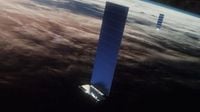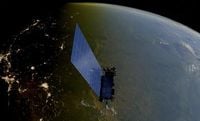If you’ve glanced up at the night sky recently and spotted what looked like a shooting star, there’s a good chance you were actually witnessing the fiery demise of a Starlink satellite. In 2025, the spectacle of satellites streaking across the heavens has become a near-daily occurrence—one that’s as awe-inspiring as it is concerning. According to Jonathan McDowell, an astronomer at the Harvard-Smithsonian Center for Astrophysics, Starlink’s satellites are now deorbiting at a rate of one to two per day. That number is expected to climb rapidly, potentially reaching five per day as the Starlink constellation continues to expand (EarthSky).
It’s a remarkable shift in the rhythm of our skies. Before SpaceX’s Starlink network began launching in 2019, only about 40 to 50 satellites would re-enter Earth’s atmosphere globally each year. Now, that number is matched in mere weeks. SpaceX, led by Elon Musk, has already launched more than 8,000 Starlink satellites, with over 2,000 sent into orbit just this year. The company holds regulatory approval for up to 42,000 satellites, and competitors like Amazon’s Project Kuiper and China’s planned GW constellation are ramping up their own launches. According to Dr. McDowell, with all these constellations deployed, “we expect about 30,000 low-Earth orbit satellites (Starlink, Amazon Kuiper, others) and perhaps another 20,000 satellites at 1,000 km from the Chinese systems.” (EarthSky)
Why the sudden surge? Starlink satellites, and many of their rivals, are placed in low Earth orbit (LEO), roughly 550 kilometers above the planet. This altitude is ideal for delivering fast, low-latency internet to remote areas. However, it also means that the satellites are relentlessly tugged by atmospheric drag, gradually losing altitude until they plunge back to Earth. Each Starlink satellite is designed for a lifespan of about five years, after which it’s guided into a controlled descent to ensure it burns up in the atmosphere—at least, in theory (EarthSky, HotHardware).
SpaceX insists that its satellites are engineered to “fully vaporize” during re-entry, leaving “no debris impact on the ground or atmosphere beyond trace amounts of natural byproducts.” The company claims that over 95% of each satellite’s material is vaporized before reaching the ground. But as Dr. McDowell noted, “Every few months there’s a report of a piece of space hardware that’s reentered that ends up on the ground as a significant piece of debris. So, several times a year we’re taking these potshots at people on the Earth and fortunately, so far missing. So far, we’ve been very lucky but it won’t last.” (EarthSky)
The risks aren’t limited to falling debris. When satellites re-enter the atmosphere at speeds of up to 25,000 kilometers per hour, the intense heat—often exceeding 1,600°C—vaporizes metals like aluminum, which then form aluminum oxide particles. These particles linger in the mesosphere and stratosphere, and their environmental impact is only beginning to be understood. According to a 2023 study from the University of British Columbia, satellite re-entries may already account for up to 10% of all aluminum oxides detected in high-altitude atmospheric samples—a share projected to rise sharply by 2030 (University of British Columbia).
Scientists are concerned that these particles could reflect sunlight, subtly altering Earth’s radiative balance and potentially contributing to localized warming or cooling. They may also disrupt ozone chemistry, posing a risk similar to that of other atmospheric aerosols. A separate investigation by the National Oceanic and Atmospheric Investigation found exotic metals like niobium, hafnium, copper, lithium, and aluminum at concentrations far higher than those found in natural space dust—pointing to satellites and spent rocket boosters as the likely culprits (NOAA).
One study estimated that Starlink’s deorbiting process adds about 15,000 kilograms of aluminum oxide to the upper atmosphere every six months, increasing the daily load of cosmic dust by approximately 10% (HotHardware). Dr. McDowell acknowledged the uncertainty: “It’s not clear yet really, even in the age of the mega constellations, [whether] these effects are going to be big enough to be really problematic, but it’s not clear that they won’t. That research is underway right now, and if it comes back that we’re already doing damage to the atmosphere in this way, we’re going to have to rethink some of our disposal strategies.” (EarthSky)
There’s also the looming threat of Kessler syndrome, a scenario where collisions between satellites trigger a runaway cascade of debris, potentially rendering parts of low Earth orbit unusable. Dr. McDowell warned, “For the low-orbit satellites we expect a five-year replacement cycle, and that translates to 5 reentries a day. It’s not clear if the Chinese will orbit-lower theirs or just accelerate us to chain-reaction Kessler syndrome.” Fortunately, because SpaceX’s satellites are in relatively low orbits, they’re less likely to become trapped in such a chain reaction, unlike competitors who may place satellites higher, where debris can linger for decades or even centuries (EarthSky).
Despite the risks, the sky isn’t falling—at least, not yet. But the sheer scale of the “megaconstellation” era is prompting urgent calls for regulation and research. Dr. Alice Gorman, a space archaeologist at Flinders University, argues that “space sustainability must extend beyond orbit—to what happens when objects come home.” Experts are urging governments and space agencies to treat re-entry emissions as a form of pollution, requiring reporting, modeling, and mitigation strategies. Potential solutions include developing biodegradable or non-metallic satellite materials, coordinating international deorbiting schedules, and expanding atmospheric monitoring to track long-term changes (Flinders University).
Meanwhile, the U.S. Space Command is tracking more than 20,000 active and defunct satellites, with SpaceX accounting for nearly half of all operational spacecraft in orbit. Amazon and China’s plans could quadruple Earth’s orbital population within a decade, raising the stakes for collision risk, re-entry frequency, and environmental oversight (U.S. Space Command).
For now, the sight of a satellite burning up in the atmosphere is a reminder of both human ingenuity and the unintended consequences that come with it. As Dr. McDowell puts it, “The Starlink re-entries are not a crisis—yet. But they are a preview of what’s coming when tens of thousands of satellites start aging out of service. The sky is getting busy in both directions.”
As the world’s space ambitions soar, the question isn’t just how we get up there—but how, and at what cost, we come back down.


